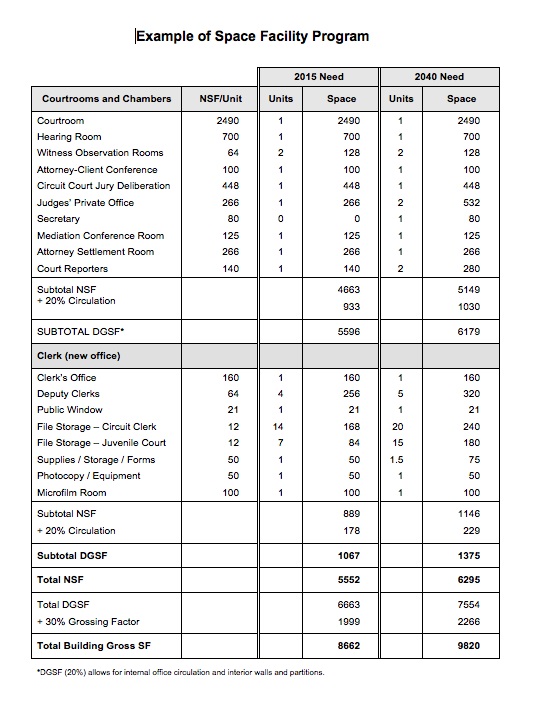Calculating Gross Square Footage Requirements
Courthouses are different from most other building types in the amount of space required because they are relatively inefficient in terms of gross-to-net square-footage ratios. Planning with this in mind will ensure that total building areas are calculated correctly, and that project budgets are sufficient to address the actual requirements.
Main lobby areas, bulk storage areas, and major mechanical systems are best treated as Net Assignable Spaces to ensure sufficient space.
Net Square Feet (NSF)
Net square feet (NSF) is the amount of space required for a particular function, such as a single workstation, exclusive of interior walls or circulation space around the functional area. The NSF is the assignable, or functional, space in the building often referred to as Net Assignable Space.
See the Space Planning Guide for typical space requirements for each function.
Departmental Gross Square Feet (DGSF)
To make functional spaces work with each other, such as a cluster of offices or workstations, a circulation factor is added to the NSF. The circulation factor adds space for interior walls and partitions, internal corridors, and circulation among functional components. This additional circulation space is referred to here as the Calculate Departmental Gross Square Feet (DGSF) by adding 15 percent to 25 percent of the NSF, depending upon the type of space.
The DGSF needed for administrative purposes in a courthouse is reasonably consistent with similar requirements in commercial office or government administration buildings. Highly specialized areas within a courthouse, such as courtrooms and holding facilities, however, require considerably more internal circulation.
To link various functional departments within a courthouse, and to transport people among floors in compliance with building codes, additional space has to be added to the DGSF. Basic core functions, beyond net assignable square feet, and beyond DGSF, are required:
- Major public corridors linking departments
- Private corridors linking courtrooms, judges' chambers, jury deliberation rooms, and other dedicated courtroom-support spaces
- Secure corridors linking courtrooms with prisoner detention facilities
- Public elevators and elevator lobbies
- Private and secure elevators
- Stairs
- Mechanical, electrical, and plumbing chases
- Public toilet facilities
- Exterior walls of the building
Building Gross Square Feet (BGSF)
Because courthouses have unique security and circulation requirements, more total space is needed to make individual departmental areas work than in an office building. Courthouses require additional private corridors and private and secure elevator cores. Judicial facilities must handle large numbers of people with efficiency and a sense of decorum. As a result, main lobbies, elevator cores and elevator lobbies, and public corridors must be larger than in a typical office building. This additional space is referred to as Building Gross Square Feet (BGSF).
An appropriate BGSF multiplier for courthouses is typically 1.20 to 1.30 of the DGSF.
Refer to the Space Facility Program to see how Net Square Feet (NSF), Departmental Gross Square Feet (DGSF), and Building Gross Square Feet (BGSF) might be calculated for a hypothetical courthouse.

There is a tendency to underestimate the total area required for a new courthouse. Net assignable areas can be programmed according to appropriate space standards. But if planning, programming, and conceptual design do not consider the unique space efficiencies of courthouses and the higher grossing factors needed, then total area and total budget requirements are likely to be underestimated.